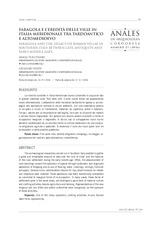Mostrar el registro sencillo del ítem
Faragola e l'eredità delle ville in Italia meridionale tra Tardoantico e Altomedioevo
| dc.contributor.author | Turchiano, María | |
| dc.contributor.author | Volpe, Giuliano | |
| dc.date.accessioned | 2018-01-15T11:19:09Z | |
| dc.date.available | 2018-01-15T11:19:09Z | |
| dc.date.issued | 2016 | |
| dc.identifier.issn | 1130-9741 | |
| dc.identifier.uri | http://hdl.handle.net/10396/15833 | |
| dc.description.abstract | Le ricerche condotte in Italia meridionale hanno consentito di acquisire dati di grande interesse sulla ‘fine delle ville’ e sulle nuove forme del popolamento rurale altomedievale. L’abbandono delle residenze tardoantiche spesso si accompagnò alla spoliazione radicale di alcuni ambienti, con una sistematica pratica di recupero e riciclo di rivestimenti, materiali da copertura, arredi e tubature. Fornaci, vasche per la decantazione dell’argilla, forni per la rifusione dei metalli e calcare furono impiantate. Tali episodi non devono essere ricondotti a forme di occupazioni marginali o degradate. In alcuni casi si svilupparono nuovi nuclei abitativi caratterizzati da un discreto livello di cultura materiale e da una vocazione artigianale, agricola e pastorale. Si evidenzia il ruolo dei nuovi poteri laici ed ecclesiastici e delle autorità pubbliche. | es_ES |
| dc.description.abstract | The archaeological researches carried out in Southern Italy enabled to gather a great and remarkable amount of data over the ‘end of villas’ and the features of the rural settlement during the early middle age. Often, the abandonment of rural dwellings caused the spoliation of spaces through systematic and organized operations of stripping and re-use of flooring, walls’ coverings, ceilings, furniture and pipes. Ceramic kilns, sedimentation basins for clay, blast furnaces for metals and limestone were installed These operations had been traditionally interpreted as connected to marginal forms of re-occupation. In many cases, these forms of settlement grew in the same areas, yet developed a good level of material culture and crafting activities, beside agriculture and farming. Representatives of the new religious and laic élites and public authorities were recognized, as the sponsors of these activities. | es_ES |
| dc.format.mimetype | application/pdf | es_ES |
| dc.language.iso | ita | es_ES |
| dc.publisher | Universidad de Córdoba, Área de Arqueología | es_ES |
| dc.rights | https://creativecommons.org/licenses/by/3.0/ | es_ES |
| dc.source | Anales de Arqueología Cordobesa 27, 97-124 (2016) | es_ES |
| dc.subject | Fine delle ville | es_ES |
| dc.subject | Attività artigianali | es_ES |
| dc.subject | Reimpiego | es_ES |
| dc.subject | Riciclaggio | es_ES |
| dc.subject | Organizzazione dei cantieri | es_ES |
| dc.subject | Specializzazione | es_ES |
| dc.subject | Committenza | es_ES |
| dc.subject | End of the villas | es_ES |
| dc.subject | Spoliation | es_ES |
| dc.subject | Crafting activities | es_ES |
| dc.subject | Re-use | es_ES |
| dc.subject | Trained labor force | es_ES |
| dc.subject | Sponsorship | es_ES |
| dc.title | Faragola e l'eredità delle ville in Italia meridionale tra Tardoantico e Altomedioevo | es_ES |
| dc.title.alternative | Faragola and the legacy of Roman Villae in southern Italy between late antiquitiy and Early Middle Ages | es_ES |
| dc.type | info:eu-repo/semantics/article | es_ES |
| dc.relation.publisherversion | https://www.uco.es/ucopress/ojs/index.php/anarcor/index | es_ES |
| dc.rights.accessRights | info:eu-repo/semantics/openAccess | es_ES |

